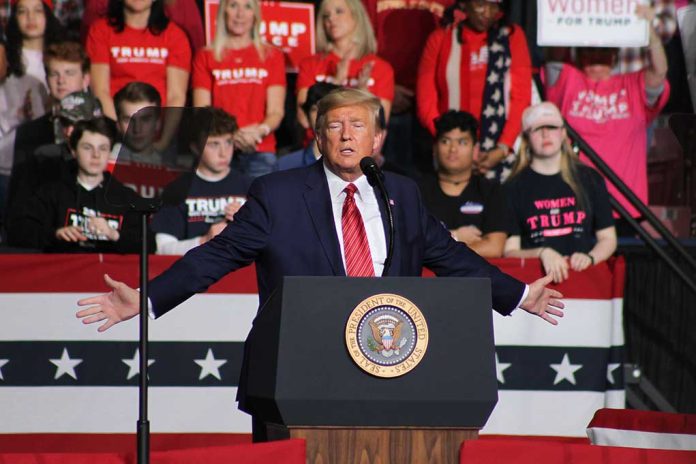
President Trump’s expansive tariff plan targeting all trading partners is set to begin, declaring April 2 as “Liberation Day” while economists and global markets brace for potential impact.
Top Takeaways
- Trump plans to implement reciprocal tariffs on all countries engaged in trade with the US, not just a limited selection of 10-15 nations as initially suggested.
- April 2, dubbed “Liberation Day,” marks the intended start date for the new tariff implementation.
- The plan involves matching tariffs imposed on US goods by other countries, with some flexibility for potential lower rates in certain situations.
- Tariffs are already in place on aluminum, steel, automobiles, and all goods from China, with more sectors expected to follow.
- Trump views these tariffs as negotiation tools to protect domestic industries and secure better trade terms for American businesses.
Trump Expands Tariff Targets Beyond Initial Scope
President Donald Trump has significantly expanded the scope of his proposed reciprocal tariff plan, announcing that it will apply to all countries engaged in trade with the United States. This move represents a substantial broadening beyond the initially suggested target of 10 to 15 nations with significant trade imbalances. The comprehensive approach signals Trump’s determination to reshape America’s trade relationships globally, not just with a select few trading partners. The announcement comes after Trump has already implemented tariffs on aluminum, steel, automobiles, and all goods from China.
“You’d start with all countries…Essentially all of the countries that we’re talking about,” Trump stated, somewhat clarifying the reach of his planned tariff implementation. This declaration contradicts earlier statements from White House economics advisors, who had suggested a more limited focus on countries with significant trade imbalances. The comprehensive approach reflects Trump’s broader economic philosophy that current trade arrangements disadvantage American workers and industries, requiring widespread correction rather than targeted interventions.
The divide in America is not political—it's a class divide separating the elites from the working class. Trump's economic agenda—a tight labor market and tariffs—raises the wages of working class Americans, which is why Wall Street, the Democrats, and their rich base hate it. pic.twitter.com/58NmuMUxnP
— Batya Ungar-Sargon (@bungarsargon) March 30, 2025
“Liberation Day” and the Tariff Implementation Timeline
April 2 has been designated as “Liberation Day” by Trump, marking the date when the new tariff structure would take effect. The symbolic naming suggests Trump views these tariffs as freeing American industries from what he perceives as unfair global competition. The February signing of a memorandum directing assessment of individual countries and their trade practices with the United States represents the groundwork for this more comprehensive approach. Each nation’s tariff structure will be analyzed to determine appropriate counter-measures, creating a tailored response rather than a one-size-fits-all approach.
The implementation timeline reflects the urgency with which Trump views trade imbalances, positioning them as immediate rather than long-term concerns. This rapid deployment strategy indicates confidence in the effectiveness of tariffs as economic tools, despite concerns from economists about potential inflationary impacts and retaliatory measures from affected nations. The accelerated schedule also suggests an intention to create immediate leverage in trade discussions, rather than prolonged negotiation periods.
Reciprocal Tariff Strategy and Potential Economic Impacts
The core principle of Trump’s tariff strategy is reciprocity – matching the fees other countries impose on American exports with equivalent tariffs on their goods entering the US market. This approach aims to create what Trump considers a level playing field for American businesses competing globally. However, Trump has also indicated potential flexibility in implementation, suggesting that in certain situations, the US might impose tariffs at lower rates than those levied by other countries, reflecting a degree of strategic nuance in the approach.
Trump views tariffs not merely as punitive measures but as negotiating tools to secure better trade terms. By implementing substantial tariffs, Trump aims to bring trading partners to the negotiating table from a position of American strength. This approach treats international trade as a competition rather than collaboration, with tariffs serving as leverage to extract concessions from trading partners. The strategy reflects Trump’s business background, applying transactional negotiating tactics to international relations.
Protection for American Industries
The expanded tariff plan represents Trump’s approach to protecting domestic industries from what he views as unfair global competition. By imposing reciprocal tariffs, Trump aims to create breathing room for American manufacturers and producers who compete with foreign goods. This protectionist stance aligns with Trump’s broader “America First” philosophy, prioritizing domestic economic interests over global economic integration. The tariffs serve as a protective barrier, allowing American companies to compete without what Trump considers disadvantages from lower labor costs or government subsidies abroad.
While the tariff plan focuses on external trade relationships, it ultimately targets domestic economic outcomes – particularly in manufacturing-heavy regions where global competition has been most acutely felt. Trump’s approach reflects a belief that protecting these industries through tariffs will preserve American jobs and manufacturing capacity, even as critics argue such measures may increase costs for American consumers and trigger retaliatory measures from affected countries, potentially harming export-oriented American businesses and agricultural producers who rely on foreign markets.






















